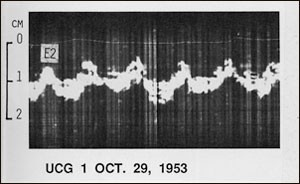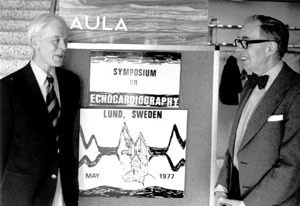Preface: Difference between revisions
No edit summary |
No edit summary |
||
| Line 12: | Line 12: | ||
The first practical use of ultrasound, using the piezoelectric crystal developed by the brothers Pierre Curie and Jacques Curie in 1880, saw light in the the first World War. Sonar was developed to detect enemy ships, and later, in 1929 Sokolov used this 'sonar' to detect flaws in metal. It was this use that developed in a valuable addition to the diagnostic arsenal of the physician. Where in the early years after the second world war anamnesis, physical examination and the electrocardiogram were the only tools for the doctor with a cardiological patient, currently, echocardiography has developed to an invaluable tool for diagnosing several cardiac diseases. | The first practical use of ultrasound, using the piezoelectric crystal developed by the brothers Pierre Curie and Jacques Curie in 1880, saw light in the the first World War. Sonar was developed to detect enemy ships, and later, in 1929 Sokolov used this 'sonar' to detect flaws in metal. It was this use that developed in a valuable addition to the diagnostic arsenal of the physician. Where in the early years after the second world war anamnesis, physical examination and the electrocardiogram were the only tools for the doctor with a cardiological patient, currently, echocardiography has developed to an invaluable tool for diagnosing several cardiac diseases. | ||
==Clinical use of echocardiography== | ==Clinical use of echocardiography== | ||
It was the German W.D. Keidel that first used ultrasound to examine volumes of the heart in 1950. But is was not until 1953 that Inge Edler, 42, and Hellmuth Hertz, 36 used a commercial ultrasonoscope borrowed by Siemens to examine the heart.[[Image:FirstEchoCor.png|thumb]] Edler, a cardiologist, described many of the current echos for the first time. [[Image:EdlerHertz.png|thumb]] | It was the German W.D. Keidel that first used ultrasound to examine volumes of the heart in 1950. But is was not until 1953 that Inge Edler, 42, and Hellmuth Hertz, 36 used a commercial ultrasonoscope borrowed by Siemens to examine the heart.[[Image:FirstEchoCor.png|thumb he first echocardiogram made by Inge Edler and Hellmuth Hertz in 1953]] Edler, a cardiologist, described many of the current echos for the first time. [[Image:EdlerHertz.png|thumb]] | ||
Revision as of 13:15, 25 September 2007
Content is incomplete and may be incorrect. |
| Author | I.A.C. van der Bilt | |
| Moderator | I.A.C. van der Bilt | |
| Supervisor | ||
| some notes about authorship | ||
This open access online echocardiography course and textbook for echocardiography is the second project of the Cardionetworks Foundation. This website is intended for Echotechnicians, Cardiology residents, and as a reference for Cardiologists. All images and movies are licensed under the creative commons license. Please feel free to contact us if you have any comments on how to improve this website. Also, if you can't find things and want us to add something we are very happy to assist you.
History of Echocardiography
It is challenging to find out who exactly were involved in the invention and development of ultrasound in general and echocardiography in particular. Facts are that a Frenchman, Martin Versenne (1588-1648) first estimated the sound of sound, and that in that time the physicist Robert Boyle (1627-1691) first noted that a medium is necessary for sound to travel. A few decades later, Abbe Lazarro Spallanzi (1727-1799) proved that bats use ultrasound to navigate. The first practical use of ultrasound, using the piezoelectric crystal developed by the brothers Pierre Curie and Jacques Curie in 1880, saw light in the the first World War. Sonar was developed to detect enemy ships, and later, in 1929 Sokolov used this 'sonar' to detect flaws in metal. It was this use that developed in a valuable addition to the diagnostic arsenal of the physician. Where in the early years after the second world war anamnesis, physical examination and the electrocardiogram were the only tools for the doctor with a cardiological patient, currently, echocardiography has developed to an invaluable tool for diagnosing several cardiac diseases.
Clinical use of echocardiography
It was the German W.D. Keidel that first used ultrasound to examine volumes of the heart in 1950. But is was not until 1953 that Inge Edler, 42, and Hellmuth Hertz, 36 used a commercial ultrasonoscope borrowed by Siemens to examine the heart. Edler, a cardiologist, described many of the current echos for the first time.
Edler, a cardiologist, described many of the current echos for the first time.
